Twinings Tea, goldsmiths, private banks & clipper ships
A visit to Twinings Tea Shop on The Strand in London used to be a mecca for tea lovers from around the world. It was also a visit with history.
The tea shop I am revealing is now anarrow sliver of an establishment that is focused
only on tea and helping you chose the right one for you. No more tea to
be drunk at Twinings in the charming tiny tearoom that used to be a part of the establishment, but you should go there to choose some tea - if only in a packet to be enjoyed with family or friends.
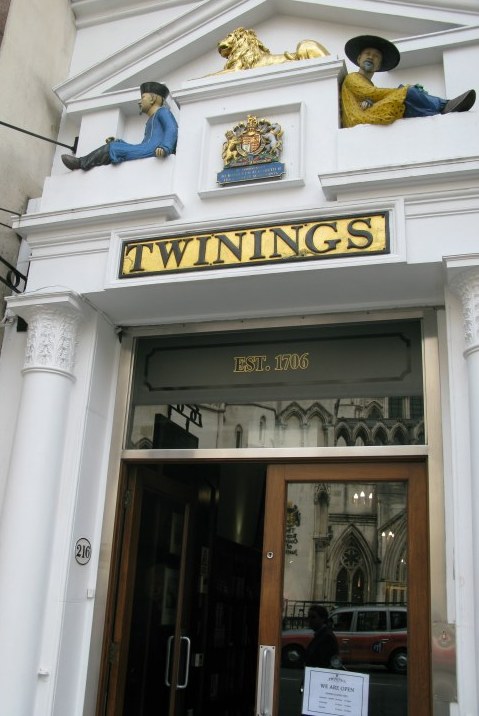
Twinings: the brand
Twinings is probably the most famous English tea firm.
The familiar design of the trademark 'Twinings of London' has remained unchanged from when it was introduced in 1778. It’s claimed to be the oldest unchanged logo in continuous use in the world.

Twinings Tea Shop
Of even more longevity, and with at least as fine a pedigree, the current establishment at 216 The Strand has housed the Twinings Tea Shop since 1706.
This length of tenure is the more remarkable for it being in a much sought-after part of London that continues to house some of the quiet powerhouses of global commerce, and for being directly opposite the high court of the land. The teashop has been revamped to be appealing in a modern minimalist design. It is without its little publicy-available tearoom, although a svelt and slick tea tasting room in the basement is now available for hire. You could sign up for their tea-tasting master class which is held there.
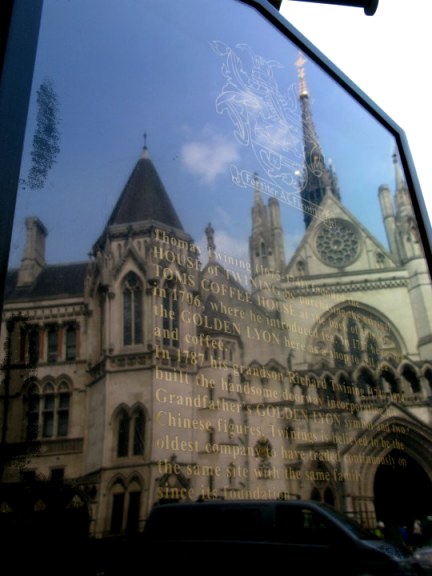
Tales of the goldsmiths
and the clipper ships
But what has Twinings tea to do with goldsmiths, private banks and clipper ships?
This is a tale that reads like an adventure story and reaches around the globe. It is the story of how new fast clipper ships were designed to respond to the need to bring fresh tea without spoilage to the waiting markets of Europe.
It is a story of a time when coinage was just starting to be regulated and The Worshipful Company of Goldsmiths became the responsible authority.
The story leaves us with a legacy from the days of the tea shop’s neighbouring 'Palsgrave's Head Tavern.'
Palsgrave is an old German word for the Elector of the German state now known as Rheinland Palatinate or Rheinland Pfalz, where I lived before returning to England, and eventually to France.
Our tale of the history of tea in England also reveals how the business that started around the drinking of tea at Twinings Tea Shop eventually initiated a publishing hub of ‘Dailies’ on Fleet Street.
So settle back with a good cup of tea, and get ready for a good read.
Here, you will discover interesting places in the heart of London that all revolve around the story of Twinings Tea. Just as choice finest tea leaves steep to make aromatic tea, these tales are steeped in English history, yet not often accurately documented.
What you read will give new meaning to a stroll along the Strand to visit an iconic tea shop.
The Strand and Twinings
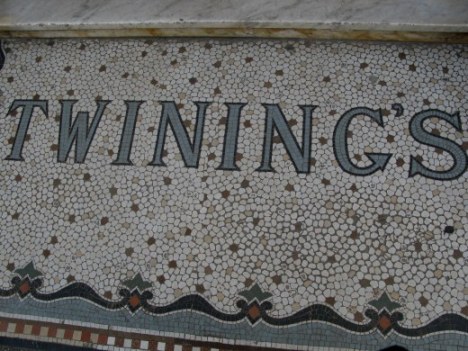
Thomas Twining had originally started selling tea from his coffee shop. The business grew rapidly. Coffee shops were the centre from which disseminated commercial information and society gossip, and as the oracles of information they became gathering places for intellectuals.
When Thomas Twining opened the first tea shop in London, tea was a new and untested drink. At the time, water was generally unsanitary and most people drank spirits or ales.
As the business grew, so did Thomas’s eventually successful lobbying to government to lower the taxes on tea. These were double per cup as that of coffee and were holding back the advancement of commerce.
The tea taxes drove a black market in cheap contraband. As poorer people couldn’t afford tea at its finest quality, they suffered from those who made unsavoury and even poisonous concoctions that were sold as tea.
These could have a basis of a variety of other material but were made to look like tea by adding such things as copper carbonate and lead chromate. By contrast, the addition of sheep manure, which was also used, seems pretty minor.
Eventually, the tea tax was repealed and subsequently the Royal Navy shortened the rum ration to a mixture of half tea and half rum. Since Admiral Vernon was responsible for this change, the new issue was named after his nickname of 'Old Grogham', so called because of the anglicisation of the French 'gros grain', a stiffened fabric that the Admiral's coat was made from, usually made of a blend of mohair, wool, and silk .
This is the source of our term: 'Grog' – although it has become more universal applied than its original meaning which was just for rum. Rum was popular with the masses and vastly preferred over water, which was generally unsafe.
Rum vs water:
before drinking fountains - not hard to choose
Following the cholera epidemic of 1854 ,when unsanitary drinking water was correctly established as the cause, in 1859 The Metropolitan Drinking Fountain and Cattle Trough Association was established.
This provided fountains with water of strictly controlled quality for the masses, and water troughs for cattle and horses.
Benefactors were at first slow to offer funds. However, by 1879 Charles Dickens noted that there were over 800 fountains and troughs under Association management.
In fact, Dickens estimated that on a summer day over 300,000 people availed themselves of the drinking fountains. He commented that one single trough had served over 1800 horses in a 24 hour period. Over history, it appears that London’s traffic congestion is perhaps not something unique to wheeled transport.
Some drinking fountains remain today, like this one on The Strand that was funded by Sir James, Baronet.
Despite there being several so named baronets around this period in London, including two Lord Mayors, my research could not reveal to whom the crowds would have given thanks for what became known as 'Adam’s Ale': fresh water.
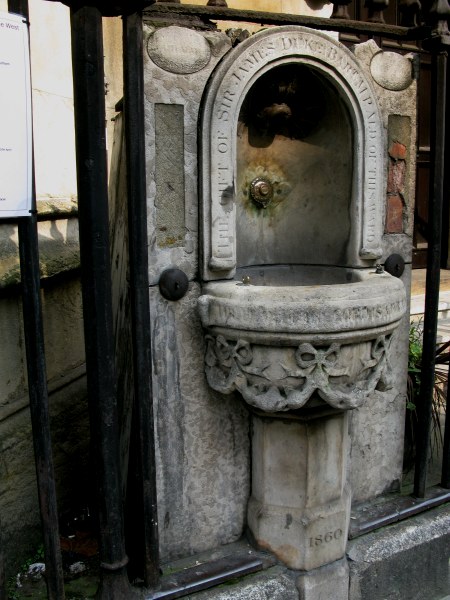
Twinings the bankers
The Twinings tea business expanded and as it did so, it brought the family into contact with wealthy and influential clients, some of whom were East India Company investors.
In 1818, George Twining moved into Twinings management together with fourth generation brothers Richard and John, and in November 1825 the family opened a bank to supplement their tea business.
Although it may seem so now, banking was not at that time a strange partner to tea trading. Banking in this era was of a different nature.
Private banks operated by the Goldsmiths had been established before the Civil War. Rich citizens entrusted their gold to the goldsmiths rather than keep it about their property or person. In turn, the Goldsmiths acted for their clients in investment transactions.
Similarly, the Twinings company had acted for its clients in buying and selling bonds in the East India Company since 1753. Since 1755 they had also been an agent for the Government lotteries. These lotteries had been run since 1709 to raise state capital and reduce interest on government debt.
Such a method of state financing was finally banned in 1826, but by then the formal Twinings banking business was well established – and each successive Twinings leader duly joined the Goldsmiths Guild who set the controls under which banking should operate.
The Twinings bank finally merged with Lloyd’s in 1892, but family involvement in the banking business only ended following the tragic death of Cecil Francis Harvey Twining in 1915 near Ypres during the first World War. He was thirty years old.
Thanks to Lloyds Bank
website,here is a reproduction print of the 1837 Twinings Warehouse and Bank.
It was located right next door to the tea shop.
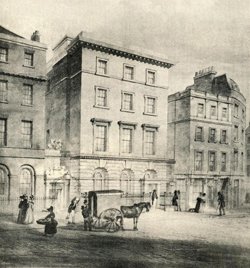
As sound as a good cup of tea:
successful bankers managing risk
In the apt words of Jaffar Hussein, Governor of the Malaysian Central Bank:
Good bankers, like good tea, can only be appreciated when they are in hot water.
Whether it was their understanding of the tea business or not, the Twinings family seems to have a head for banking and for keeping both their own and the investments of their clients out of hot water.
Their bank customers sailed safely with them through the dangerous financial years ahead:
- They survived the speculation-fuelled recession of 1857 that saw the closure of six London banks and sixty-six regional banks.
- They safely weathered the panic of 1847, brought on by the end of the railway boom. This panic led to the establishment of the Gold Standard. This meant that Parliament enacted a law to ensure that all currency would be backed by the equivalent amount of gold, thus curtailing speculative banking.
- In 1870, while other banks were found short due to unwise speculation in Argentina, the Twinings Bank was unscathed.
In between, there were many challenges caused by US and European bank failures, but continually Twinings remained profitable.
Meanwhile, the acceptance of tea had gained momentum. This was accelerated by royal support when Catherine of Braganza, the future bride of Charles II, and later Queen of England made a cup of tea her first request on alighting on English soil.
Tea under the Golden Lion
Once heavy taxes were removed, the popularity of tea never looked back.
To this day it the standard method for the British to cheer up someone – even oneself.
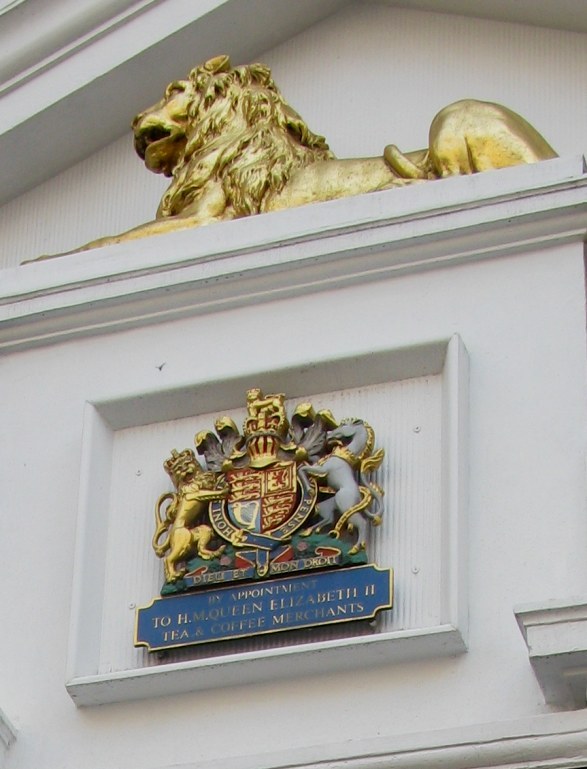
This is what the tea selection used to look like. It is now more storelike and in my opinion seems to have lost its character.
However, you can still find a selection of unblended tea kept at its premium quality for your tasting.
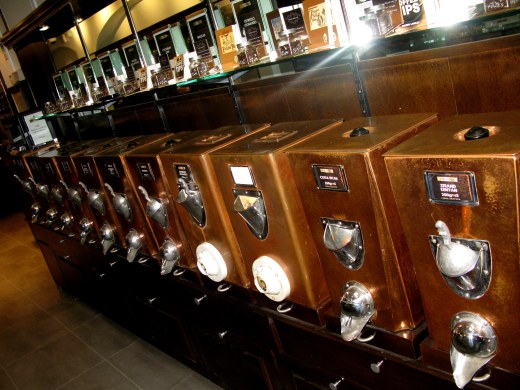
There used to beproper English teapots for sale and there are some limited ones still– not those imitations that look right, but don’t pour properly.
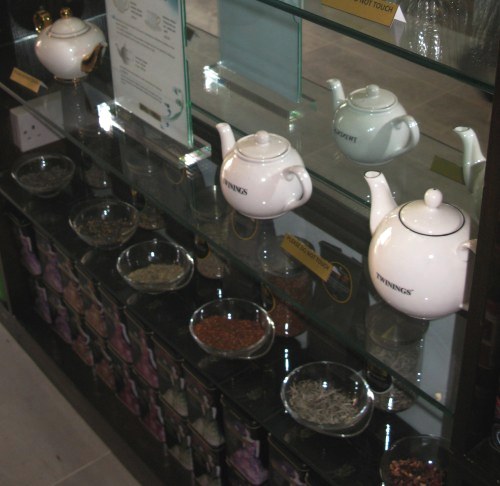
An urban myth about tips
But even the Twinings Tea Shop was prey to the powers of the urban myth, here undone by correct grammatical usage.
In the tea shop one might have seen a reconstruction of what was purported to be the origin of our use of the term 'to tip'.
It has been erroneously reported that when Twinings was a coffee house 'under the Golden Lyon' customers used to be encouraged to place a coin in the wooden box marked T.I.P. 'To Insure Promptness.' This is purported to be the origin of the word 'tip' - meaning a gratuity.
In fact, were that the case, it would be T.E.P. as the correct English would be “To ENSURE Promptness”, not “INSURE”.
Semantics claims that the real origins of the verb 'to tip' come from what was known as cant. According to old documents, this was a secret language that was used by 'thieves, rogues and gypsies'. The attribution of the word solely to this group was due to the fact that the vocabulary of cant was all about sleight of hand and thieving, with 'tip' meaning to pass across, or transfer ownership.
But Twinings until reduced in size, used to also sell coffee and the Little Books of Tea/Coffee Tips make worthy purchases.
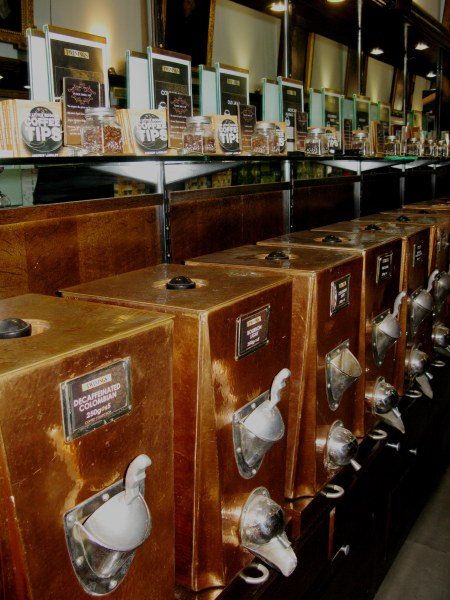
Twinings: a latecomer to the power
of the coffee shops and tea houses
Twinings did not have the monopoly on tea houses, nor was theirs the first.
Tea thought to have been imported from Holland had first been made available to the English public at the ‘Sultaness Head’ around 1685.
The Sultaness Head was situated close to the Royal Exchange and was more a political and commercial London hub than coffee house.
After the Great Fire, which started at the Exchange, the re-opened coffee house took on the name of its owner, the commercially astute Thomas Garway whose family ships had served in the Armada, earning grandfather Garway a knighthood. In the reign of Charles I, when sea trade was the core of Britain’s wealth and therefore centre focus of its interest, Cousin Sir Henry, a contemporary of Thomas, became Master of the 'Drapers, Mercers, and Grocers Guild', and Lord Mayor of London.
Along with other wealthy merchants and citizens, the Lord Mayoral colleagues of Sir Henry frequented Garway’s coffee house, for here was the hub of all trading news. It was here that tea took over from coffee as the tipple of choice.
Around 1688, a pamphlet published by Garway advertised ‘An Exact Description of the Growth, Quality, and Vertues of the Leaf Tea’. This directly countered claims about tea being hazardous to one’s health and indeed, seemed to find tea to be good for whatever ails you.
What Garways was to The Exchange, the Palsgrave’s Head Tavern, just three doors along from Twinings Tea Shop, was to the Inns of Court and the Royal Courts of Justice. It also housed a coffee house that served tea.
The Palsgrave’s Head was so highly esteemed that it became the temporary refuge for the Archbishop of Canterbury in 1688.
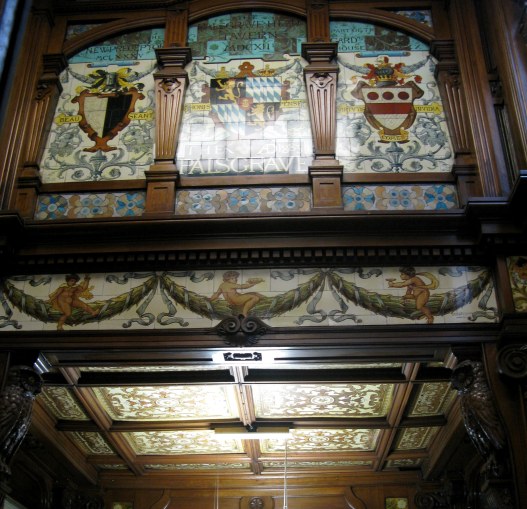
A tale of bad omens at the coronation:
the Archbishop, the river, and the safe haven
The Archbishop in question was one William Sancroft, the 79th Archbishop of Canterbury.
Despite being the senior bishop and religious leader of the Church of England, Sancroft had agreed to perform the coronation of Catholic James II and Mary of Modena, on the basis of securing in return a proclamation of the safety of the Church of England under James’s rule. The coronation was a momentous occasion for the country, as the last one had been that of Henry VIII and Catherine of Aragon on Midsummer’s Day 1509.
However, according to records at Westminster Abbey, there were said to be two bad omens on the day: the crown seemed to fall off the head of James just as he was crowned, and at the same moment, the royal standard at the Tower of London was ripped apart by high winds.
Omens aside, King James soon sowed the seeds of his undoing by establishing his own Ecclesiastical Court, the intent of which was widely believed to be to return the country to Catholicism.
Given that the day prior to the official coronation at Westminster Abbey, James had been anointed and crowned already in a Roman Catholic service in a chapel at Whitehall, this seems to have been an understandable concern.
The trouble that arose for Archbishop Sancroft was when the first proclamation by the Ecclesiastical Court was to be read from pulpits across the land. This proclamation set the rights of both religions as equal under the law, seen to be Step One in a return to Catholicism.
This placed the clergy in an impossible position between loyalties to the King on the one hand, and their faith on the other.
England was a protestant country and Archbishop Sancroft was its spiritual head. A usually quiet and unobtrusive man, the Archbishop of Canterbury was a man of deep loyalty to his church and mindful of the implications of him doing so, refused to read the proclamation. He called upon his Bishops to come to London in support.
Although eighteen of them agreed with him, only seven could make it to London in time – Lloyd of St. Asaph, Turner of Ely, Lake of Chichester, Ken of Bath and Wells, White of Peterborough, and Sir Jonathan Trelawney of Bristol.
So began the Trail of the Eight Bishops, an event that would be pivotal in the unpinning of the new monarch. For his stance and the summoning of his supporters in the faith, eventually Archbishop Sancroft was forced to flee Lambeth Palace, and when he did, it was by travelling down the Thames to the Palsgrave’s Head.
Twinings Tea Shop neighbour:
From coffee house to bank
A part of this significant milestone in the battle of church and state, the Palgrave’s Head stands with us still on The Strand in all its former grandeur – but we know it as Lloyd’s Bank, Law Courts Branch.
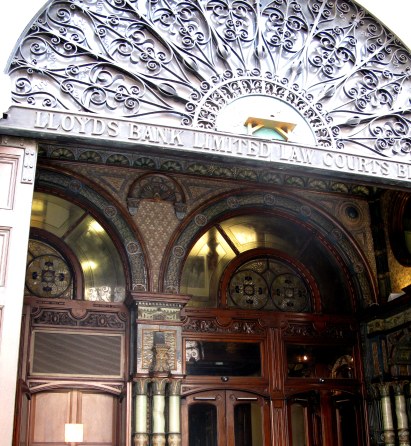
It is easy to see why Lloyd’s named it is so, as The Royal Courts of Justice sit directly opposite.
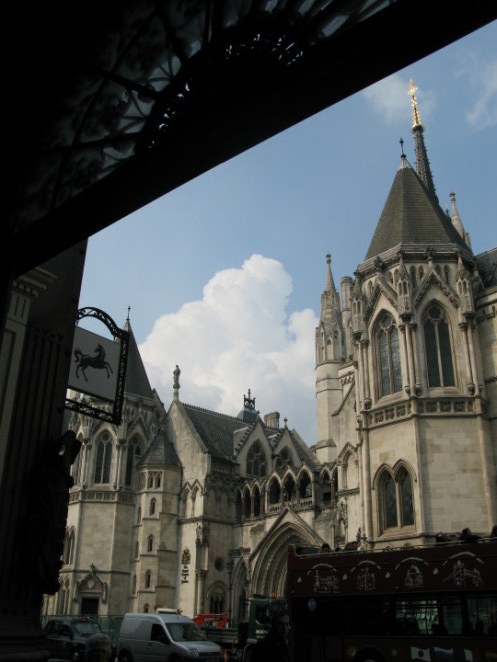
The former Palgrave's Head is a magnificent building right beside the entrance to the Outer Temple of Temple Bar.
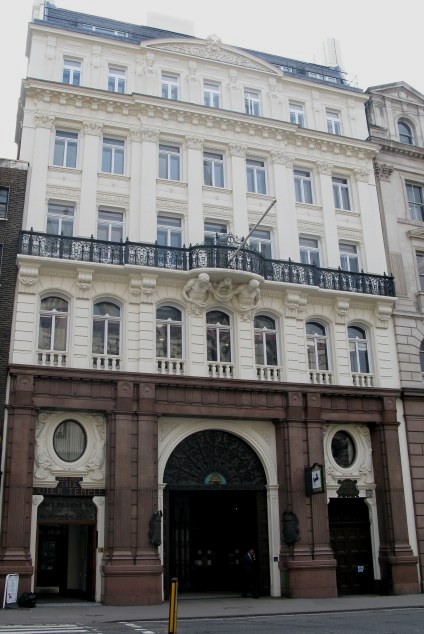
The Palsgrave’s Head Tavern had a sense of the historical even before it became a political refuge for the Archbishop, for on a front panel is this quote from Shakespeare’s Henry VI, when Warwick says:
I love no colours. I pluck a white rose with Plantagenet.
It reflects the part of the play where, in the Temple Gardens beside the tavern, to indicate their loyalties, lawyers and noblemen pick either the white rose of York, or the red Lancastrian rose.
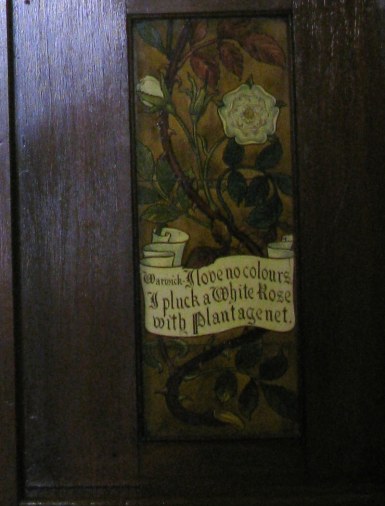
This elaborate décor continues into what is now the banking chamber.
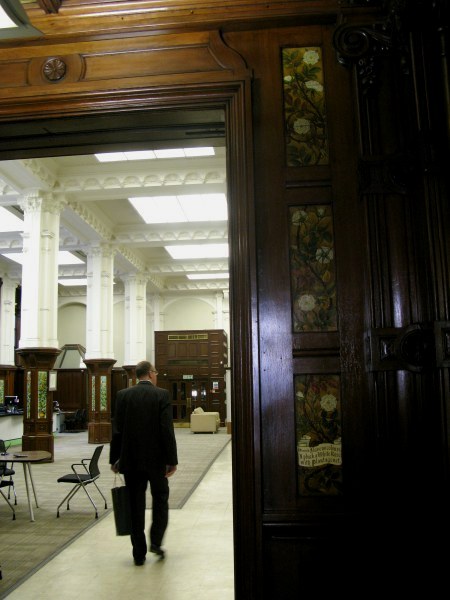
The amazing front court was in its earlier life protected against the passing populace by bars across the Strand entrance.
Its opulence remains for us to admire today.
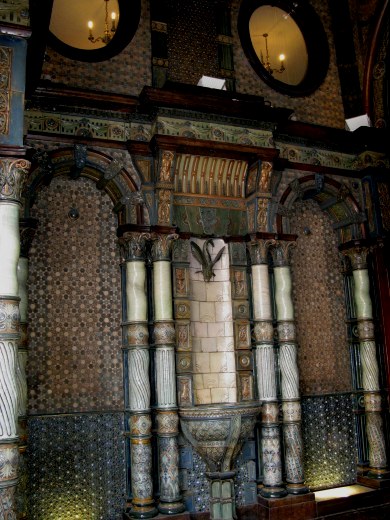
It must be one of the most elegant cash machines sites for a backpacking tourist in the whole of London.
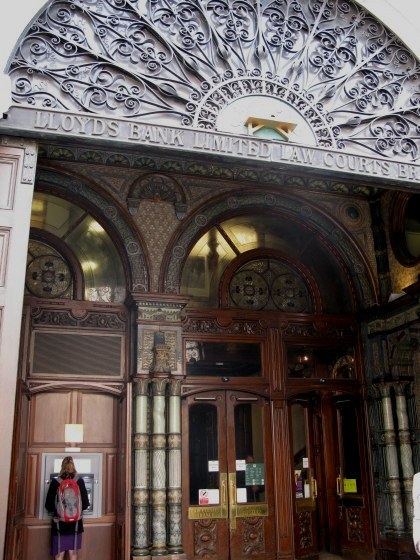
The entrance features a range of Doulton tiles and 'sanitary ware', as the fountains and drain pipes were termed.
The market dominance of the Doulton works in that era is directly attributable to the son of the founder, Henry, who turned from aspiring clergyman to industrial entrepreneur.
Junior Doulton was quick to realise the opportunity offered by the sewage and drainage systems revolutionising the streets of Britain’s cities, and Doulton production fell into swing with the need.
Without these unglamorous products, Doulton would not have been able to support the Lambeth Studios, an offshoot of the Lambeth School of Art.
It was from here that the more rapid and individual production of hand painted artistic works, especially tiles, brought about a revolution in the ceramics industry.
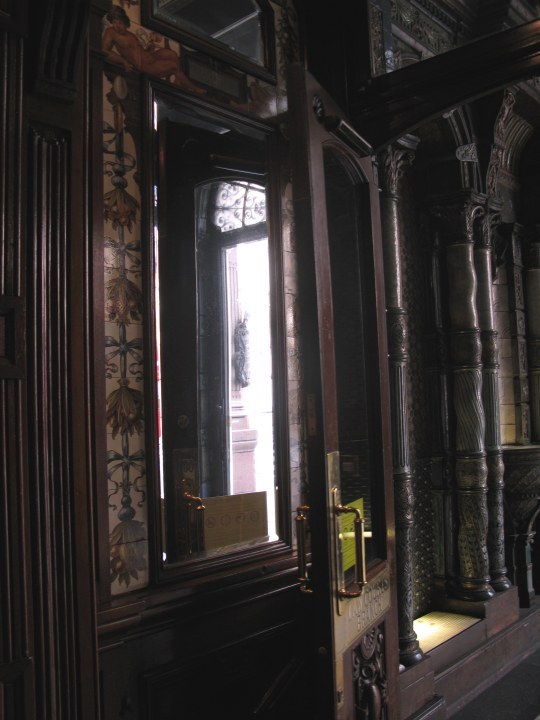
The economic success and international acclaim of this unique mix of art and industry, led to the opening of art departments in all the great British potteries as others hastened to capitalise on the newly established markets for such products.
Henry Doulton was a truly astute commercial business leader. Soon his Artistic Director, C.J. Noke was successful in convincing Henry to move into bone china production. Noke’s experimental glazes rivaled anything the old European potteries could offer.
The Flambes, Titanian, Sung, Chinese Jade, Chang and Crystalline glazes made the Doulton Burslem factory a world leader: its technology and artistic development were unrivalled.
It was said that Douton aimed to make things better than anyone else, faster, and in vaster quantities.
Having already in 1885 received the Albert Medal from the Royal Society of Arts, Henry was knighted by Queen Victoria in 1887.
His solid business foundations were the basis for the company through successive
generations until its final closure in 1956 when, like many famous brands, it
became part of the Royal Doulton group of companies that in 2015 celebrated the 200th anniversary of the brand. In 1955 new city regulations prohibited the use of salt glaze at the Lambeth factory, and the production moved to Stoke-on-Trent, home of the potteries.
Today, the Lloyds Bank Law Courts Branch retains the former elegance of the Palsgrave’s Head Tavern, adorned with Doulton works of art.
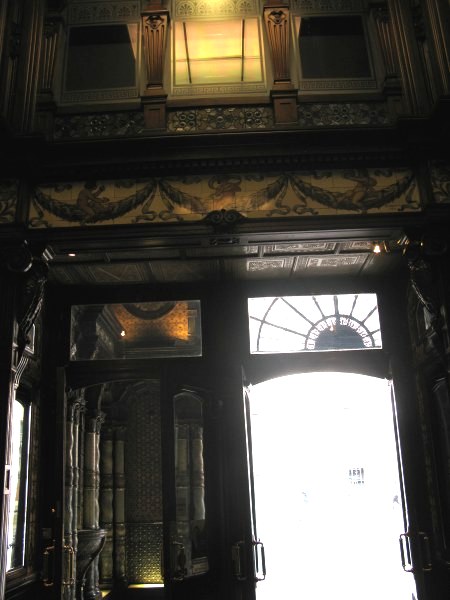
Tokens for tea
Like most such traders of the times, both the Sultaness Head and the Palsgrave’s Head issued their own coinage in the form of tokens.
Each tavern, coffee house, merchant or other commercial venture that issued tokens had its own distinguishing mark. Witty statements abounded, not all as polite as this:
Though I'm but brass, yet let me pass
Here courtesy of tsiosophy-com, is an example of one issued by the Palsgrave’s Head.
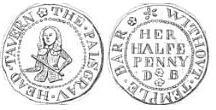
There is no record of the specific origins of the tavern name, and so the image on the token could refer to Frederick V who married Elizabeth Stuart, daughter of James I and Queen Mary, or one of the two sons, Charles Louis or Rupert, who both spent much time at the English Court.
Rupert was a much honoured Royalist in the Civil War, while Charles Louis, whose character was described in papers of the time as a German despot, sided with the parliamentary party – for which his relatives never forgave him.
Frederick became King of Bohemia. He was only a Palsgrave upon marriage, awaiting his official accession as Elector, but he did have extensive land holdings, a list of which were read at Court, presumably to justify the unon.
Such was the importance of political marriage allegiances, that to redress this perceived imbalance of status, Frederick was inducted to the Order of The Garter, the insignia of which he wore for his marriage to Elizabeth.
This was the same Elizabeth who was only nine when she was a target for kidnapping by the Gunpowder Plotters. They planned to kidnap her, kill her non-catholic relatives and place her as a puppet on the throne.
The
plot was foiled by the capture of Guy Fawkes, who was to become a
puppet of a different kind, an effigy that for centuries later was flung
onto bonfires across the realm on the 5th November - Bonfire Night.
Later, and briefly, Frederick would be King of Bavaria, and in contrast to the more famous Queen Elizabeth of Bavaria known on the continent as ‘Sissi’, due to the brevity of her reign, this Elizabeth is often known as the Winter Queen.
The term proved most fitting in a wider sense. After her triumphal return to Heidelberg as a young bride and the first few years of apparently happy marriage, her husband’s fortunes followed an accelerating downhill slide, including the loss of his hereditary Rheinland estates.
After his death, Elizabeth return unheralded to England.
Tea Shop tokens to official currency
This was a period when the whole issue of currency beset the Crown.
Elizabeth I wrestled with issues of status, declining to have the currency of the land represented by less than fine metals.This stalled proposals for copper coinage which would have been available to the common man.
Eventually however, problems of unsecured promissory notes and tokens demanded remedy, and in 1672 copper farthings were issued with Britannia resplendent on the reverse side.
Despite the official currency, traders tokens still remained in common use until all but the currency of the sovereign was banned in 1665.
The private bank that tutored Twinings
In this context, it could be said that all traders were bankers of sorts at the time when the family set up the Twinings Bank: but there were private banks too.
One of the most notable established private banks of the era and one with whom the Twinings had previously trusted their fortunes, was that of the Messrs. Hoare.
Perhaps the Twinings long-term success in banking stems from observations of Hoare banking principles. Certainly these have been principles able to remain intact since the Hoare Bank opened in 1672.
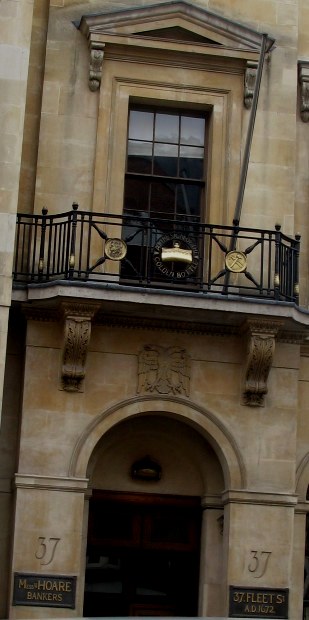
It is a fascinating piece of British history that of the 750 private deposit banks that have existed in England and Wales in the 17th and 18th centuries, only C.Hoare & Co. has survived intact to today. The family-owned business decided against merger with the larger banking groups, still hvaing involvement from 12 generations of the family (as of 2025).
It deserves some clarification about the nature of a private bank, as they are not establishments with which the average person has acquaintance.
The term 'private banking' purely refers to the level of services that are offered. These banks are fully regulated and act as do any other bank – but as they cater to high net worth individuals, their range of services differs.
Not just anyone can join the Hoare bank, as they prefer to match expectations and philosophy.And their philosophy could be the hallmark of their longevity.
Apart from the financials, which are even more robust than before, thier philanthropic efforts should be given credit.This from the Annual Report 2024
Over the course of the year, the bank made charitable donations
of £12.0m to The Golden Bottle Trust (GBT) – an increase on the
previous year, when the total was £6.5m. The partners continue
to donate an average of 10% of the bank’s profits to charity each
year
The giving of the Trust focuses on four of the UN SDGs . The Annual Report of C.Hoare & Co report is a document worth reading - not something said lightly.
When considering its contributions to the community, with £1.3 billion on deposit at the Bank of England (2024) and having a remarkable track record of managing risk effectively since their founding, this is a quintessentially British institution.
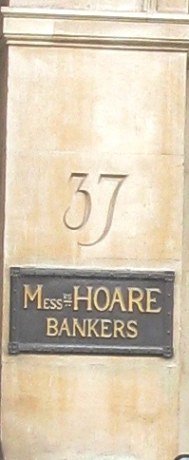
Banking under the golden bottle
- where your banker shares your risk
As Alexander Hoare, then CEO of the Messrs Hoare Bank said in an interview for Forbes magazine in November 2009, being a private bank and not driven by shareholders gives an opportunity to act in the best long-term interests of their customers.
This is not an unimportant component of the trust that people of high net worth place in the Hoare Bank, for the Directors of the bank jointly share the responsibility for the funds on deposit. They are in the truest sense, banking partners, for they stand to lose the most by frivolous decisions.
Another benefit of being a small private bank is that information is more readily accessible when required by auditors and regulators.
As Alexander Hoare said during the same interview, he would challenge a traditional bank CEO to know exactly where the information is, and on what computer system. His parting comment of the interview is a commercial gem:
'No one ever talks about the diseconomies of scale'.
The current Fleet Street premises of the Hoare Bank was established in 1690.
Here, for eleven generations the bank was directly managed by family members until in 2009 a former Credit-Suisse senior banker joined as CEO.
The greats of history have banked here: not just the Twinings, but Lord Byron, Jane Austin, Samuel Pepys, Disraeli, and even Catharine of Braganza – she who popularised tea.
Still fronted by the 'Golden Bottle' the building has the oldest British purpose-built banking hall.
The distinctive 'Golden Bottle' insignia dates from pre-street-numbering times, when symbols identified premises.
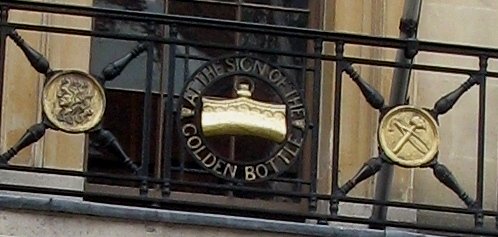
Banking legacy to the nation
Not only has the family bank formed an important part of the fabric of London since 1690, but the Hoare family name is also associated forever with two quintessentially English properties, now both managed by the National Trust.
Glastonbury Tor, once known as Ynys yr Afalon – or as translated ‘The Isle of Avalon’ – was bought by Richard Colt Hoare in 1786. Some important restoration was made before it passed to other owners.
Although now recognised for its historic importance, this was not earlier the case. Richard Colt Hoare was an early archaeologist when the profession was at its birth. He recognised the significance of the provenance of Glastonbury Tor and spent a great deal of effort in the restoration.
For those not aware, Glastonbury Tor is where records place the two coffins of King Arthur and Guinevere of the Arthurian legends. It is such a part of English culture that the recreated Tor was the staging ground for the opening ceremony of the London Olympics in 2012.
The other property is of almost equal significance to the historical landscape of England.
In 1717, Stourhead in Wiltshire was bought by Henry Hoare I, son of the founder of Hoare’s bank. Here, in the newly designed stately home he had built, the family displayed art treasures collected from around the world.
His only son and heir having been killed in the action in World War I, Henry Hugh Arthur Hoare passed the house and gardens to the management of the National Trust just a year before his own death in 1947.
The gardens and the mansion with its magnificent library are a world-wide attraction to this day. The interior of Stourhead is etched in many memories from the 2005 film ‘Pride and Prejudice’.
It is apparent that the Hoare family had not just wealth but an eye for beauty as well.
We are indebted to them for their contributions to our historic landscapes.
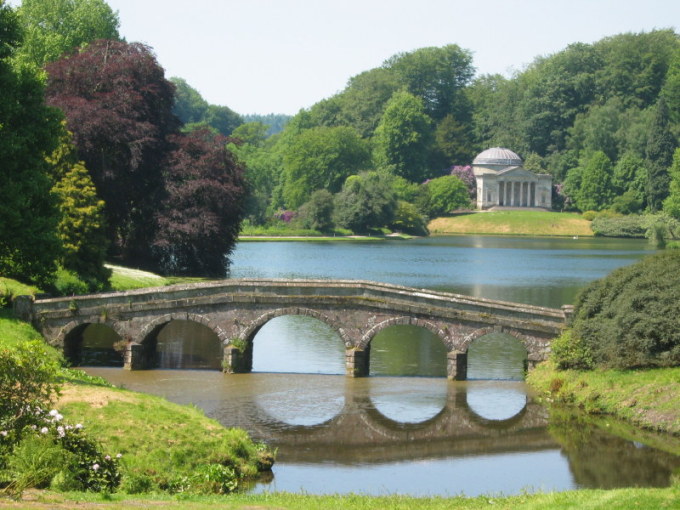
Twinings Tea and the clipper ships
Just as Goldsmiths and bankers are linked to Twinings Tea, so is the history of the clipper ships.
Today, Twinings sells Cutty Sark tea tins or caddies (green and black) in a tribute to this most famous vessel, the only surviving clipper ship.Here Twinings tells their tale of the Cutty Sark
Although on its first voyage Cutty Sark’s payload was such that even in today’s commoditised market it would be valued at over £1million, the vessel had come to sea just as the Suez Canal was being opened.This gave dominance to the speed and economy of steam ships in the tea trade.
However, Cutty Sark made eight tea voyages, bringing tea enough for over 160 million cups of tea. Her later years were spent as a general freighter. Following her career as a tea-clipper, she first became known as the fastest ship hauling wool from the Australian colonies.Later she was renamed and her world voyages were based from Portugal. In the 1920s she was bought and refurbished for public view. Cutty Sark is a must see in London where it is part of the Royal Museums, Greenwich.
Cutty Sark later returned to nautical service as a training ship for the Thames Nautical Training College at Greenhithe, near Dartford, in Kent. She was used for seamanship training right up to and during World War II, and in 1954 moved to her current home in Greenwich.
In their day, the clipper races were not sport but very serious business.It was all about who could get their tea leaves to the waiting English market fastest before they lost the freshness – and therefore capture the premium prices for the new luxury.
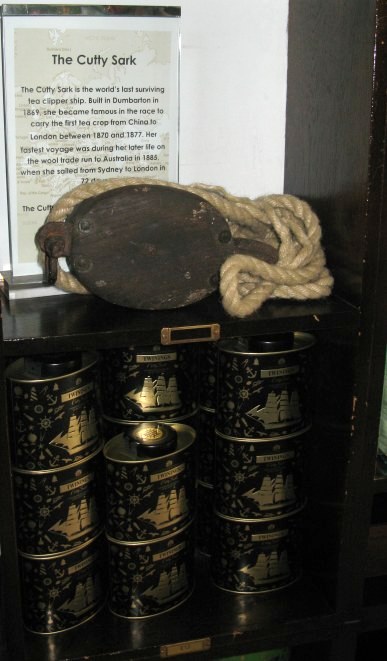
Tea: the anchor point of London.
Fancy a pot ?
One could say that tea is the anchor point of London, for Harrods and Fortnum and Mason also have rich heritage in the industry.
London has lots of places other than those designed to cater to the tourist who knows but a few names and therefore pays dearly for an experience that most real tea drinkers would think was inferior.
‘Time Out’ magazine suggests that in their view, in 2024, the best Afternoon Tea to delight you in London will be at the Ritz.
Every day Britons reputedly drink over 165 million cups of tea versus only about 70 million cups of coffee.
Why not join them?
To
finish off your pleasure at how a good cuppa tea is the hub of all things
English and how Twinings Tea Shop in London is your key to understanding so
much more than tea in the history of that corner of London, settle back with a
fresh pot of tea and enjoy the Proms concert of the famous Shostakovich
orchestration of the classic ‘Tea for Two’, conducted here by Vassily
Sinaisky: You can hear it here.
As you listen, bear in mind the sage who was watching the kettle boil and drew the following lesson on dealing with life’s ups and down:
Consider the tea kettle.
It is up to its spout in hot water but it still sings.
Other London Pages






